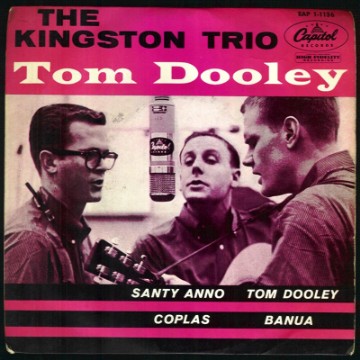November 17, 1958
- STAYED AT #1:1 Week
The Number Ones is a new column where I'll review every single #1 single in the history of the Billboard Hot 100, starting with the chart's beginning, in 1958, and working my way up into the present.
The most interesting thing about the Coen Brothers' Inside Llewyn Davis -- and, as far as I can tell, the most accurate -- was the way the Coens depicted the early-'60s Greenwich Village folk scene as something other than a hive of starving geniuses bouncing ideas off of each other. Instead, the movie showed us an anachronistic form of mercenary capitalism. These young people clearly took themselves seriously, but they were also hustling to make a buck -- to put together a catchy-enough novelty song, or to craft a salable persona, or to land a decent-paying gig at a Chicago nightclub. And all of them were, in one way or another, trying to be the Kingston Trio.
The Kingston Trio weren't from Greenwich Village; they were from San Francisco, by way of Hawaii and San Diego. But their phenomenal, hard-to-explain late-'50s popularity was a huge part of the reason the folk music boom happened in the first place. Folk-music historians and activists like Harry Smith, Pete Seeger, and Woody Guthrie helped shape the popular image of folk music as a noble American tradition, but the Kingston Trio were the ones who actually succeeded in turning it into pop. And the song that made them famous was "Tom Dooley," a nearly century-old traditional about a former Confederate soldier and prisoner of war who murdered one of his lovers.
Tom Doula was a real person, a North Carolina Civil War vet who, for reasons never quite discovered, murdered a woman named Laura Foster in 1866 and who was hung for it. The song existed in a number of different forms before the Kingston Trio got their hands on it. They made it into a chaste choirboy singalong that never gave any sense of the fear or rage or pain or uncertainty of any of the song's characters. Rather than digging into the song's specifics, the Kingston Trio used it as a showcase for their tastefully plucked banjos and their bleached-out harmonies.
Heard today, "Tom Dooley" sounds like the rankest kind of poverty tourism, and the fact that the people involved were real human beings makes it grosser. The members of the group do what they can to resurrect those old forms, but they sound like buttoned-up patricians, not like narrators who could've actually known any of the people involved. It's a flat, detached piece of music. And at the first-ever Grammy Awards, in 1959 -- where "Nel Blu Dipinto di Blu (Volare)" won both Record Of The Year and Song Of The Year -- "Tom Dooley" took home the trophy for Best Country & Western performance, despite not being a remotely country or western song. (No folk award existed at that point.) And thus began the grand Grammy tradition of handing out awards that don't make any sense at all.
GRADE: 2/10
BONUS BEATS: Here's Neil Young & Crazy Horse's eight-minute version of "Tom Dooley," from the 2012 album Americana:






